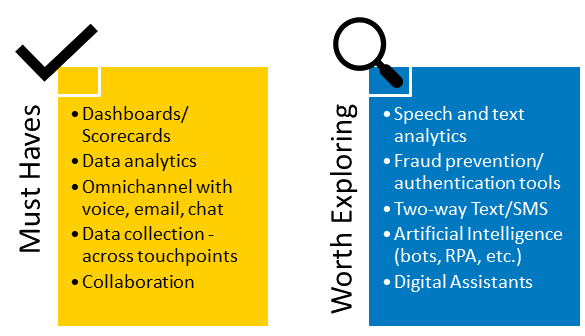As we end 2018 and reflect on what’s ahead in 2019, it seems like a good time to think about what’s new and what’s next in contact center technology. My team of consultants identified the top things we see dominating contact center technology discussions. Here’s a quick summary before I dive into the commentary:

Artificial Intelligence tops the list for consideration – because even if you aren’t thinking about it, your boss may be! My biggest hot button is differentiating AI from pure “business rules” approaches because that’s what will determine how “new” or transformative it is. Here’s a quick contrast:
| Business Rules | Artificial Intelligence |
| Rules-based (if…then…), recognizes key words or phrases | Leverages AI and Natural Language Processing to understand and trigger actions |
| Pre-defined responses | Conversational responses |
| Only as smart as it is programmed (static) | Capable of intelligent conversation and self-learning (dynamic) |
| Typically developed to perform simple and repetitive tasks | Responds to questions and provides advice and guidance |
| Understands and acts on pre-defined commands | Understands and acts on requests |
| More simple development and maintenance | More complex development and maintenance |
| Typically text or trigger based | Can be driven by text, voice, triggers |
While cloud has been around a long-time and is well accepted at this point, it is not a “one size fits all” world, nor one that has become static in solution types or vendor offerings. Choices extend beyond private cloud and public cloud, or single tenant versus multi-tenant. There are hybrids of many sorts, and now licensing approaches for premise-based solutions that neutralize one of the reasons that compelled many to consider cloud. Chances are, no matter what your vision, there is a cloud solution for you, or a premise approach that delivers some of the benefits you like about cloud while retaining your preferred premise solution characteristics.
Omnichannel is old news but new and changing in the sense of people waking up to the pain of their siloed channels. Administration and vendor management, license and maintenance costs, routing, reporting and analytics, and user interfaces are all places where the problems manifest. Add in the operational compromises these things create, and enough volume for those compromises to add up, and the case for change becomes compelling.
Analytics is something every enterprise and center needs, and most have some level of focus here. Unfortunately, few have enough resources on it, the data sources and structures they need, and the right tools to really evaluate all that data and drive insights and actions. Data analytics is a good starting point provided that you rethink how you handle it rather than churn out the same old canned reports. Speech analytics can help with very center-specific improvements, such as optimizing quality monitoring, and providing insights that drive process, training, and other improvements. Text analytics provides insights about emails, chat, and text messages, not to mention the notes that agents capture about customer interactions.
Fraud prevention/authentication tools are one of my favorite topics, because so many centers face challenges here. The villains show no sign of letting up, and customers are increasingly frustrated with knowledge-based authentication (questions, passwords, etc.). Many technologies can play a role here, including targeted fraud detection or authentication solutions from vendors such as Pindrop, TRUSTID, and NextCaller, or biometrics solutions from Nuance, NICE, Verint, and others. Tools built into our mobile devices – for fingerprints, facial recognition, iris scans, etc. – can also play a role when the mobile application is integrated into the contact center (omnichannel!).
Collaboration tools are not new or unique to the center, and the center often has an enterprise tool for instant messaging and presence. However, getting collaboration tools right is about technology and the associated policies on what to use when. That could lead to removing excess tools, focusing real-time communication in a tool with alerting and non-real-time information in tools that are accessed at specific times.
Digital Assistants from Amazon, Google, Apple, and others still hold the potential to change how your customers might “speak” to your company. Centers need to think about how the demographic of the customer base is using these tools and what their expectations will be. If your customers want to talk to these things instead of an IVR, you should be ready!
